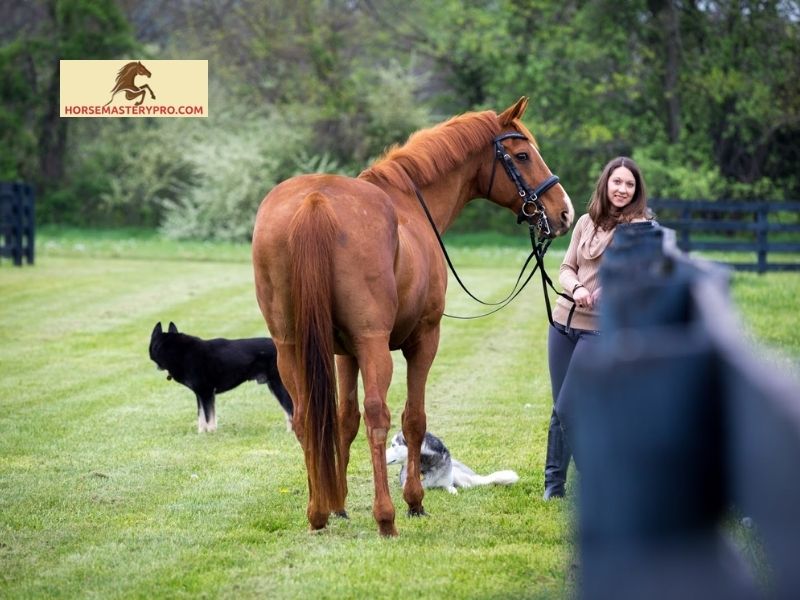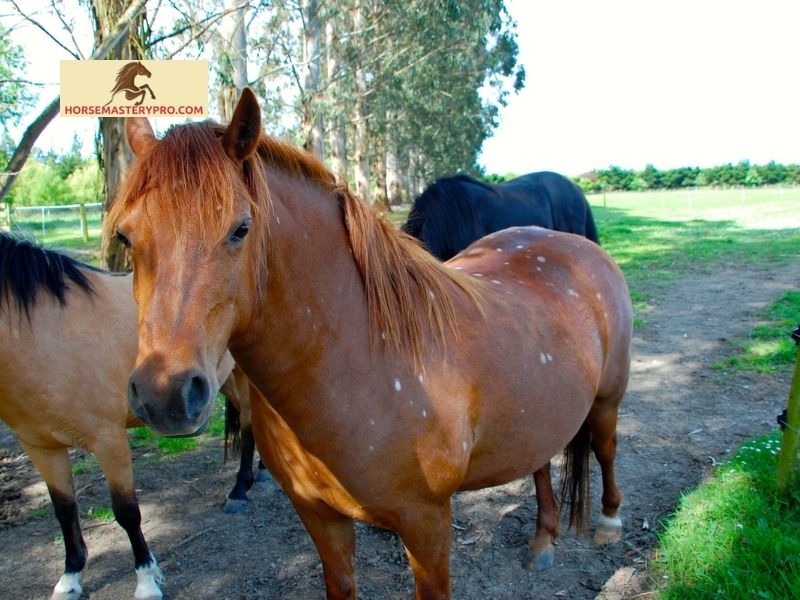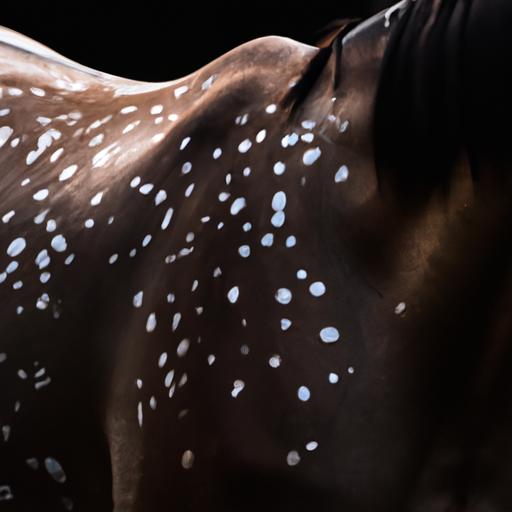Discover the secrets of birdcatcher spots on horses. Learn about prevention and management strategies, breeding considerations, and veterinary care options.
Introduction

Picture this: you’re strolling through a picturesque pasture, marveling at the graceful beauty of horses. Suddenly, your eyes catch sight of peculiar markings on their coats. What could those be? Ah, birdcatcher spots! These enigmatic spots have piqued the curiosity of horse enthusiasts for ages. But why are they so important? And what causes them to appear?
In this article, we embark on an exciting journey to unravel the mysteries of birdcatcher spots on horses. Together, we’ll explore the significance of identifying these spots and gain a deeper understanding of their origins. So, saddle up and let’s delve into this captivating equine phenomenon.
A. Importance of Identifying Birdcatcher Spots on Horses
Imagine you’re a horse owner, and you notice peculiar spots on your beloved companion’s coat. Naturally, you may wonder if these spots hold any significance. Well, wonder no more! Identifying birdcatcher spots is crucial as they can provide valuable insights into a horse’s genetic makeup and overall health. These spots can serve as visual indicators of potential underlying conditions or hereditary factors, allowing for early detection and proactive management.
B. Brief Explanation of Birdcatcher Spots and Their Causes
Birdcatcher spots, also known as “coon spots” or “domino spots,” are fascinating markings that grace the coats of some horses. These spots appear as small, irregularly shaped patches of white or lighter-colored hair amidst the horse’s natural pigmentation. While they may vary in size and location, birdcatcher spots are most commonly found on the horse’s body, particularly around the flanks, hips, or chest.
But what causes these captivating spots? Well, the exact mechanisms remain somewhat elusive. Birdcatcher spots are believed to be genetically inherited, stemming from the influence of specific genes within a horse’s lineage. Additionally, environmental factors, such as exposure to sunlight or certain diseases, may trigger the appearance or intensify the visibility of these spots.
Now that we’ve laid the groundwork, let’s dive deeper into the world of birdcatcher spots on horses. Together, we’ll explore the telltale signs, implications, and even strategies for prevention and management. Stay tuned for the next section, where we’ll unravel the secrets behind identifying these distinctive markings.
Stay connected with Horsemasterypro.com to uncover the hidden secrets of birdcatcher spots on horses.
words
Understanding Birdcatcher Spots

A. Definition and Description
To truly understand birdcatcher spots, we must first define and describe them. Birdcatcher spots are unique markings that manifest as small, irregular patches of white or lighter-colored hair on a horse’s coat. These spots can vary in size, shape, and intensity, adding a touch of intrigue to the horse’s appearance. They create a mesmerizing contrast against the horse’s natural pigmentation, captivating the eyes of admirers.
B. Common Locations on a Horse’s Body
Birdcatcher spots have a penchant for certain areas on a horse’s body. While they can appear anywhere, they tend to favor specific locations. Keep a keen eye out for these spots around the flanks, hips, chest, or even scattered across the body. It’s essential to inspect these areas carefully, as birdcatcher spots may hide in plain sight, blending subtly with the horse’s coat.
C. Differentiating Birdcatcher Spots from Other Markings or Conditions
Now, you may be wondering, how do we distinguish birdcatcher spots from other markings or conditions? It’s essential to develop an astute eye to avoid confusion. Birdcatcher spots can sometimes be mistaken for other coat patterns, such as sabino or roan. However, there are distinct characteristics that set birdcatcher spots apart.
Unlike sabino or roan markings, birdcatcher spots do not spread or fade with age. They remain consistent in appearance throughout the horse’s life, serving as a permanent feature. Additionally, birdcatcher spots are irregular in shape and tend to appear individually rather than in clusters. These unique traits help in identifying and differentiating birdcatcher spots from other coat patterns or markings.
Now that we have a solid understanding of birdcatcher spots and their distinguishing features, it’s time to explore the various techniques and visual cues for identifying these captivating markings. Join me in the next section as we unravel the secrets to spotting birdcatcher spots on horses.
Stay connected with Horsemasterypro.com to uncover the hidden secrets of birdcatcher spots on horses.
words
Identifying Birdcatcher Spots on Horses

When it comes to identifying birdcatcher spots on horses, keen observation and a discerning eye are key. Let’s delve into the techniques that can help us uncover these intriguing markings and distinguish them from other coat patterns or conditions.
A. Visual Inspection Techniques
To begin our investigation, we rely on the power of sight. A thorough visual examination of a horse’s coat is the first step in identifying birdcatcher spots. Take a closer look at the horse’s body, paying particular attention to the flanks, hips, and chest areas where these spots are commonly found. Look for irregular patches of white or lighter-colored hair that contrast with the surrounding pigmentation.
B. Physical Characteristics and Color Variations
Birdcatcher spots exhibit distinct physical characteristics that set them apart from other markings. These spots are typically irregular in shape, varying in size from tiny specks to larger patches. They may appear as solid spots or exhibit a speckled or mottled pattern.
Color variations within birdcatcher spots also add intrigue to their appearance. While most spots appear white against a darker coat, some may display shades of gray, cream, or even roan. These variations contribute to the unique charm of each horse and make birdcatcher spots a fascinating subject of study.
C. Common Misconceptions and Potential Confusion with Other Markings
Birdcatcher spots, though distinctive, can sometimes be mistaken for other coat patterns or conditions. It’s essential to differentiate them from markings such as dapples, flea-bitten gray, or even scars. While dapples are circular or oval-shaped, birdcatcher spots tend to be more irregular in their formation. Flea-bitten gray horses have speckled coats, but the distribution and pattern differ from birdcatcher spots.
Additionally, it’s crucial to avoid confusion with injuries or scars that may resemble these spots. A keen eye and knowledge of the horse’s history can help identify the true nature of the markings.
Now that we’ve honed our identification skills, let’s move forward to uncover the causes and implications of birdcatcher spots on horses. Join me in the next section as we unravel the captivating stories behind these enigmatic coat patterns.
words
Causes and Implications of Birdcatcher Spots
Take a moment to ponder: what lies beneath the surface of these captivating birdcatcher spots? In this section, we delve into the fascinating causes and implications surrounding these enigmatic markings on horses. Let’s explore the intricate web of genetic factors, environmental influences, and potential health implications that birdcatcher spots may reveal.
A. Genetic Factors and Hereditary Transmission
Birdcatcher spots, like hidden treasures, often have their roots embedded deep within a horse’s genetic makeup. These spots are believed to be inherited through specific genes that pass down from generation to generation. While the exact genes responsible for birdcatcher spots remain a subject of ongoing research, their presence can provide valuable insights into a horse’s lineage.
Through careful breeding considerations, it’s possible to selectively propagate or minimize the appearance of birdcatcher spots within a horse’s lineage. This knowledge empowers breeders and horse enthusiasts to make informed decisions, ensuring the preservation of desirable traits and minimizing potential health complications associated with these spots.
B. Environmental Influences and Triggers
Nature has a way of leaving its mark, and birdcatcher spots are no exception. While genetics play a significant role, environmental factors can also influence the visibility and intensity of these spots. Exposure to sunlight, particularly UV radiation, can stimulate the pigmentation of these spots, making them more pronounced. Additionally, certain diseases or skin conditions may trigger the appearance or exacerbate the visibility of birdcatcher spots.
Understanding the environmental triggers and influences can help horse owners and caretakers make informed decisions regarding their horses’ living conditions and management. By minimizing exposure to potential triggers, such as excessive sunlight or known irritants, it may be possible to reduce the prominence or occurrence of birdcatcher spots.
C. Health Implications and Potential Complications for Horses
While birdcatcher spots themselves are generally harmless, they can serve as indicators of underlying health conditions or potential complications. In some cases, these spots may be associated with certain genetic disorders or predispositions to skin conditions. Therefore, it is crucial to monitor the overall health and well-being of horses exhibiting birdcatcher spots, seeking veterinary care when necessary.
By staying vigilant and proactive, horse owners can ensure the optimal health and happiness of their equine companions, addressing any potential complications associated with birdcatcher spots promptly.
Together, we’ve unraveled the intricate causes and implications of birdcatcher spots on horses. But our journey isn’t over yet! In the next section, we’ll explore preventive measures and effective strategies for managing these distinctive markings. Stay tuned to uncover the secrets of prevention and management!
words
Conclusion
As we wrap up our exploration of birdcatcher spots on horses, we have gained valuable insights into these unique markings and their significance. By identifying birdcatcher spots, we can unlock a deeper understanding of a horse’s genetic makeup and overall health. Early detection of these spots allows for proactive management, ensuring the well-being of our equine companions.
Throughout this journey, we have learned that birdcatcher spots are not merely superficial embellishments on a horse’s coat. They hold hidden secrets about the horse’s lineage and potential health concerns. By paying attention to these spots, we can make informed decisions when it comes to breeding considerations and horse selection.
In addition, environmental and dietary adjustments play a vital role in managing birdcatcher spots. Providing a suitable environment, protecting horses from excessive sunlight, and ensuring a balanced diet can help mitigate the appearance or intensity of these spots.
When it comes to the well-being of our horses, veterinary care and treatment options should not be overlooked. Consulting with a trusted equine veterinarian can provide valuable guidance and assistance in managing any underlying health conditions associated with birdcatcher spots.
Remember, as horse owners and enthusiasts, it is our responsibility to stay vigilant and observant. By understanding and addressing the presence of birdcatcher spots, we can ensure the health and happiness of our equine companions.
Thank you for joining me on this captivating journey into the world of birdcatcher spots on horses. If you want to delve even further into the world of horsemanship, visit horsemasterypro.com. Together, let’s unlock the secrets of mastering the art of horsemanship.
Unveil the hidden secrets of birdcatcher spots with Horsemasterypro.com.
words


